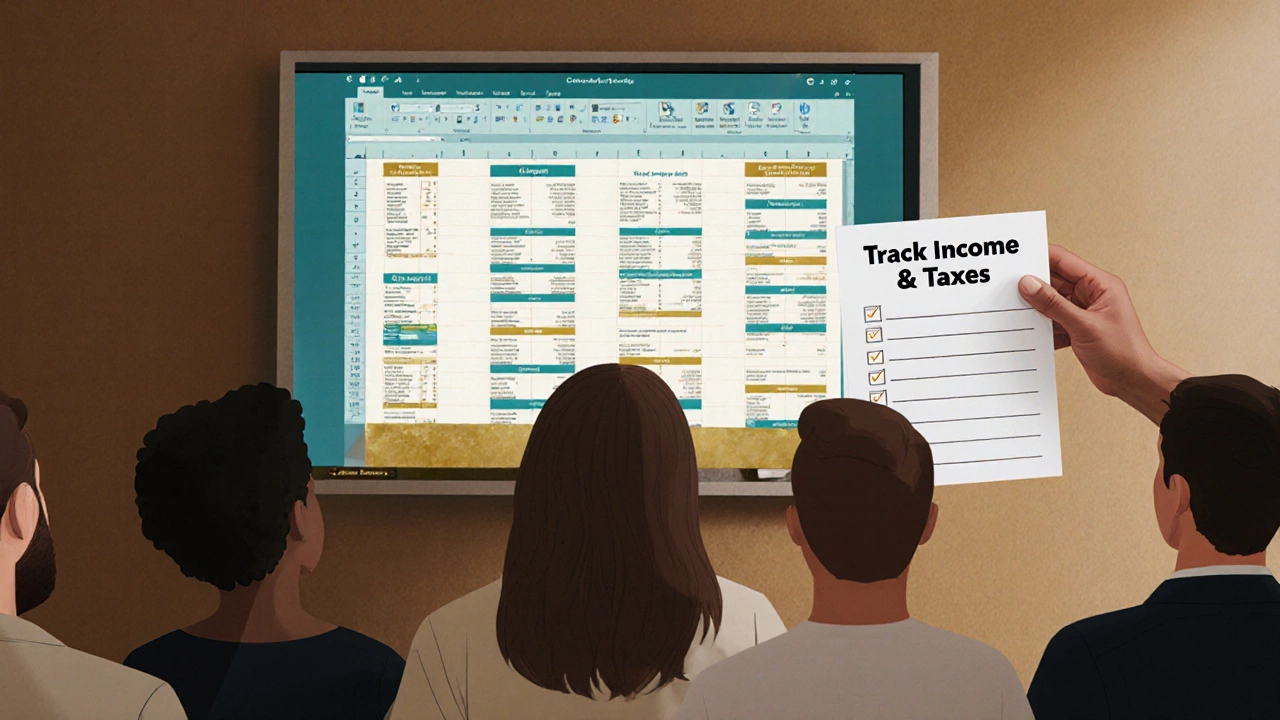eLearning Course Profit Calculator
Course Revenue Calculator
Estimate your potential earnings from your eLearning course based on platform choice, pricing, and expected sales volume.
How It Works
This calculator helps you understand the financial impact of different platform choices and pricing strategies for your eLearning course.
Pro Tip
Most successful courses charge $49-$149. Higher prices often correlate with better perceived value and fewer sales volume requirements.
Estimated Monthly Revenue
Enter your course details above to see your potential earnings.
Want to make money on eLearning platforms but not sure where to start? You’re not alone. Millions of people are teaching online - not just as a side hustle, but as their full-time income. The key isn’t having a fancy degree or a big following. It’s knowing what people actually want to learn and how to package it so they’ll pay for it.
Start with what you already know
You don’t need to be an expert in quantum physics or a bestselling author to create a profitable course. You just need to know something someone else is struggling to learn. Think about the skills you’ve picked up over time - how to use Excel for budgeting, how to write resumes that get noticed, how to fix a leaky faucet, how to teach a toddler to sleep through the night. These are all valuable. People are willing to pay for clear, step-by-step guidance on real problems.Look at what’s already selling on platforms like Udemy, Teachable, or Skillshare. What topics keep appearing? Why? Often, it’s not about being the most advanced. It’s about being the most helpful. A course titled “Excel for Small Business Owners: Track Income, Expenses, and Taxes” sells better than “Advanced Financial Modeling for Analysts.” Why? Because the first one solves a daily pain point for a much larger group of people.
Choose the right platform
Not all eLearning platforms are built the same. Your choice affects how much you keep, how many students you reach, and how much work you have to do to get noticed.Udemy is easy to join - you can upload a course in under an hour. But here’s the catch: they control pricing, run constant sales (often dropping courses to $10), and take up to 75% of your revenue unless you drive your own traffic. It’s great for testing ideas, but not for long-term profits.
Teachable and Podia are better if you want to keep more money and build your own brand. You pay a monthly fee ($29-$99), but you set your own price, run your own promotions, and own your student list. You’ll need to drive traffic yourself - through social media, email lists, or YouTube - but your profit margin can be 80% or higher.
Think of it like this: Udemy is like renting a booth at a flea market. Teachable is like opening your own store. One’s easy to get into. The other takes more effort but pays off over time.
Create a course that actually sells
A good course isn’t just a bunch of videos. It’s a transformation. People don’t buy your content - they buy the result. So structure your course around a clear outcome.Instead of “Introduction to Social Media Marketing,” try “How to Get 1,000 Followers on Instagram in 30 Days - Even If You’re Starting From Zero.” The second one tells people exactly what they’ll get and how fast.
Break your course into small, digestible lessons. No one wants to sit through a 45-minute video. Keep them under 10 minutes. Use real examples. Show before-and-after screenshots. Include downloadable templates - a budget sheet, a content calendar, a checklist. These add instant value.
And don’t forget the intro video. It’s your sales pitch. In the first 60 seconds, answer: Who is this for? What problem will it solve? What will they have by the end? If you lose them here, they won’t stay.

Sell before you build
One of the biggest mistakes new creators make is spending weeks building a course - then hoping people will find it. That rarely works.Instead, test your idea before you record a single video. Post on Reddit, Facebook groups, or LinkedIn: “I’m putting together a course on [topic]. Would you buy it? What’s the biggest challenge you face?” Get 50 responses. You’ll quickly see if there’s real demand.
Then, offer a discounted early-bird price to the first 20 people who sign up. Use a simple Google Form or Gumroad link. If 10 people pay $20 before you even launch? That’s $200 in validation. Now you know it’s worth building.
Use free content to build trust
People won’t pay for something they don’t trust. So give away value first.Start a YouTube channel. Post 5-10 short videos on your topic - “3 Mistakes People Make When Starting a Side Hustle,” “How I Made My First $500 Selling an Online Course.” These don’t need to be fancy. Just authentic. Include your course link in the description.
Or start a free email newsletter. Send one tip per week. After 4-6 emails, invite readers to your paid course. People who opt in already like what you share. They’re warm leads.
This isn’t about being “helpful” for the sake of it. It’s about proving you know what you’re talking about - without asking for money upfront.
Scale beyond one course
Once you’ve got one course selling consistently, don’t stop. Use what you learned to build more.Look at your students’ questions. What do they ask after finishing your course? That’s your next product. If you taught “How to Start a Dropshipping Store,” maybe your next course is “How to Scale to $10K/Month Without Hiring Staff.”
You can also bundle courses. Offer a “Beginner to Pro” package at a discount. Or create a membership site where people pay $20/month for new lessons, live Q&As, and templates.
Some top creators make 70% of their income from upsells, not their original course. The first course gets them in the door. The rest keeps them profitable.
Watch out for these mistakes
Most people fail not because they don’t know how to teach - but because they make avoidable errors.- Waiting for perfection. Your first course won’t be flawless. That’s fine. Launch it, get feedback, then improve.
- Ignoring marketing. If you build it and don’t tell anyone, no one will come. Even the best course needs promotion.
- Underpricing. $19.99 feels safe. But $99 feels valuable. People associate price with quality. Test higher prices. You might be surprised.
- Not collecting emails. If you only sell on Udemy, you don’t own your audience. Always collect emails - even if you’re selling elsewhere.
Real results, real people
Sarah, a former HR manager, started teaching resume writing on Teachable. She spent 3 weeks recording 12 videos and added a downloadable template. She priced it at $49. She shared a free tip on LinkedIn every day for two weeks. Within a month, she sold 120 copies. That’s $5,880. She didn’t quit her job - yet. But she’s now working on her second course: “How to Ace Virtual Interviews.”James, a plumber, made a course on “DIY Home Plumbing Fixes” after helping neighbors for years. He uploaded it to Udemy, ran a $10 promo, and got 800 sales in 6 months. He now makes $8,000/year from it - while still fixing pipes.
You don’t need to be famous. You don’t need a studio. You just need to solve one real problem for one real group of people.
Can I make money on eLearning platforms without showing my face?
Yes. Many successful courses use screen recordings, animations, slides, or voiceovers without ever showing the creator. Focus on clear audio, clean visuals, and helpful content. Your expertise matters more than your appearance.
How long does it take to start earning from an eLearning course?
Most people start seeing sales within 2-8 weeks after launching - if they promote it. Building the course might take 2-6 weeks. But the real time sink is marketing. If you post consistently on social media or email your list, you’ll get traction faster. Some creators make their first sale in under a week.
Do I need to be an expert to create a course?
No. You need to be one step ahead of your student. If you’ve solved the problem once, you can teach it. Many top sellers aren’t industry leaders - they’re people who figured out how to do something practical and documented it clearly.
What’s the most profitable niche in eLearning right now?
Right now, the highest-converting niches are personal finance (budgeting, side hustles), productivity (time management, Notion templates), mental wellness (anxiety tools, sleep routines), and AI tools for everyday tasks (like automating emails or writing prompts). These all solve urgent, daily problems people are willing to pay to fix.
How much can I realistically make?
Most creators make between $500 and $5,000 per month in their first year. Top sellers make $20,000+ by selling multiple courses, running memberships, or using paid ads. Your income depends on your niche, marketing effort, and how many courses you build. It’s not a get-rich-quick scheme - but it’s one of the most reliable ways to build passive income online.
What to do next
Start small. Pick one skill you’ve mastered. Write down 5 problems people have with it. Record a 10-minute video solving one of them. Upload it to YouTube or LinkedIn. Add a link to a free checklist in the description. If 10 people download it, you’ve found your audience. Now build the paid version.You don’t need permission. You don’t need a degree. You just need to start.








